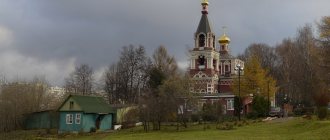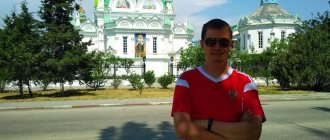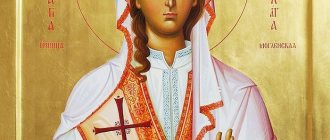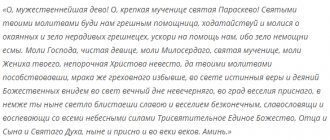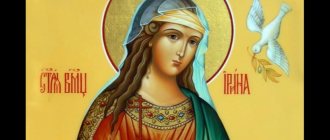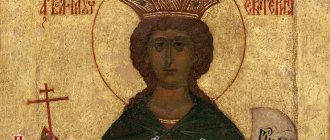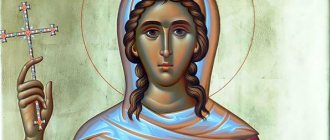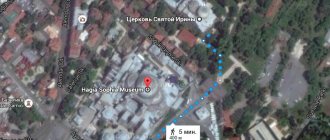Having looked at it once, it is difficult to confuse it with some other - it is a painfully unique look. Let's try to describe it in words.
This five-domed basilica has a vaulted roof, a nave and two side aisles. Together the dome and form a cross - in this case it is a Cypriot version of the Byzantine style. A square chapel with a dome and apse vaults is located in the south-eastern part of the temple and resembles an ancient mausoleum. Presumably there was a baptistery (a special building for baptism) there, and later the room began to be used as a chapel. It is clearly visible in the foreground of the next photo.
It is believed that before the construction of the church, there was an ancient temple or early Christian basilica in its place. Initially the church was dedicated to Saints Barnabas and Hilarion. But in the middle of the 19th century it was consecrated in honor of Saint Paraskeva. A little later (in 1886 and 1893), the bell tower and vestibule were added, and the western wall was demolished to expand the church.
How did the Pyatnitskaya Church appear?
14 years after the capture of Kazan by the troops of Ivan IV the Terrible, a wooden temple of St. Nicholas of Zaraisk was built in the center of the capital of the former Khanate. The new church had a Pyatnitsky chapel and in the 16th century was considered one of the tallest buildings in Kazan.
In 1579 there was a devastating fire in the city. A strong fire destroyed the entire north-eastern suburb and residential buildings near the Kremlin. Trouble did not spare the wooden church of St. Nicholas of Zaraisky - it burst into flames overnight and burned to the ground. For a long time, the ashes remained empty; they did not dare to build anything on it.
When Kazan became rich, stone buildings began to appear in the city. As a rule, churches and civil buildings were erected not at government expense, but at the expense of merchants or donations from parishioners.
In 1728, wealthy merchant Ivan Afanasyevich Miklyaev allocated money for the construction of a new temple for workers of the local cloth factory. When everything was ready, the main altar was consecrated in honor of the feast of the Epiphany, and one of the two aisles of the stone church was dedicated to Paraskeva Pyatnitsa, beloved by Christians.
"Special assignment" in the Church of St. Paraskeva
Let's start with the fact that when visiting Paphos, we found ourselves near the church more than once, but we examined it quite briefly. Knowing that this was a very old church, they took it for granted, without going into details. This continued until art critic Yulia Buzykina, who wrote from “her own bell tower” a whole selection of articles for our website, informed us of the next topic of the planned story. One of the frescoes that was to be photographed, according to the “assignment” received, was located in this particular temple.
And so, having planned the next conquest of the Akamas Peninsula, we decided to first drive up to the Church of St. Paraskeva in Paphos.
The door was open, but a menacing sign on it warned that photo and video shooting was prohibited here. And even only special people can conduct excursions inside the church, that is, licensed guides from the COT (Cyprus Tourism Organization - CTO). The priest sat inside and kept order.
You can't, but sometimes you can
Oblomaitis - for some reason I remembered this “Lithuanian surname” then. We came in and simply began to look at the frescoes, leaving the cameras hanging sadly on our shoulders. But after just a few minutes a miracle happened! A group of French tourists, apparently accompanied by a licensed guide, entered the church. She approached the priest, discussed something with him and gave instructions to her tourists.
Tourists, listening to her, periodically took photographs of whatever they wanted, although without flash - most likely this was exactly what the “instruction” was about. Feeling like true Frenchmen, we immediately joined the group and began to carefully examine the frescoes under the euphonious explanation of the guide in a beautiful, but incomprehensible language. “C'est la vie” was the only thing I remembered from French at that time, and we enthusiastically began clicking camera shutters in time with the rest of the group.
Now let’s get serious and tell you what the guide could talk about.
The fate of the temple in the 18th-20th centuries
The new church became the main temple for the parish, which was located next to the Kazan Mother of God Monastery. In this part of the city there lived poor people who could not donate much to the temple, so the church was supported by an Orthodox women's monastery.
Fires were the scourge of all Russian cities. Until the beginning of the 19th century, the Pyatnitskaya Church repeatedly suffered from fire. Several times it burned so badly that only bare walls remained. The parishioners had to restore the building each time, paint the interiors, and buy liturgical utensils and icons.
In 1815, there was a big fire in Kazan, after which the Pyatnitsky Church took several years to reconstruct. By 1821, only one chapel had been restored. Divine services in the main temple were able to continue only after 10 years. It was then that the church was re-consecrated and began to be called not Epiphany, but Nativity.
The Pyatnitsky chapel burned down so badly that in 1855 they were forced to rebuild and consecrate it again. It is believed that the author of the project for the restored temple was Thomas Ivanovich Petondi, a Russian architect who worked a lot in Orel and Kazan.
The history of Pyatnitskaya Church is connected with many famous people. From 1877 until the end of his life in 1914, the duties of the headman of the temple were performed by the hereditary woodcarver Mikhail Aleksandrovich Tyufilin. The talented craftsman was engaged in the manufacture and gilding of iconostases for many churches and cathedrals of the Kazan diocese. Many of Tyufilin’s creations were destroyed by time and people, but two beautiful iconostases survived. One is located in the Peter and Paul Cathedral of the city, and the other is in the temple of the Arskoe cemetery.
After the advent of Soviet power, supporters of Patriarch Tikhon in Russia began to be oppressed. Communities of so-called “renovationists” were created in different cities of the country, which included believers loyal to the policies of the new state. It was with the “renovationists” that local authorities entered into lease agreements for religious buildings.
Since 1923, the ancient church of Paraskeva Pyatnitsa was also occupied by “renovationists”. After the closure of the Annunciation Cathedral in Kazan, the Pyatnitskaya Church became the cathedral church. The city authorities allowed the transfer of liturgical utensils, icons, crosses and reliquaries from all closed and destroyed monasteries and churches of the Kazan diocese. Soon Pyatnitsky Church turned into a kind of church museum.
In the 1930s, the Soviet state tightened its policies regarding any faith. During the anti-religious campaign, not only Orthodox Christians suffered, but also Catholics, Muslims and Buddhists. In 1937, the Pyatnitskaya Church was closed to believers and turned into a transit prison. Officially, it was called “City Prison No. 6.”
Here they kept convicts who, after a court decision or meetings of the “troikas,” were waiting to be sent to camps. In the Pyatnitsky Church, guards shot people who were sentenced to death. After the sentence was carried out, the bodies were buried in or near the church. Journalist and historian Evgenia Solomonovna Ginzburg has preserved memories of the local prison.
In the post-war years, the Pyatnitskaya Church was abandoned. When the church bell tower was demolished, the former religious building finally fell into disrepair and decay. Local historians and local historians tried to attract the attention of the authorities to the architectural monument. Finally, in the 1980s, the state found money to redecorate the temple.
In 1993, the building was transferred to the balance of the Ministry of Culture of Tatarstan. Renovations began at the Pyatnitsky Church in order to later organize a museum of Orthodox icons in the building. At this time, the attitude towards religion in the country changed. A few years later, the Pyatnitskaya Church was returned to the believers, and the long restoration of the shrine began. By 2000, the lost bell tower was rebuilt next to the temple.
During the renovation work, terrible discoveries were made. Builders opened mass graves of victims of political repression. A whole cemetery was discovered in the church and next to it - many skeletons of executed people. At first, the unfortunate people were buried in the large Samosyrovsky cemetery, on the eastern outskirts of the city.
At the end of the 1990s, more than 400 remains of those executed were buried on the territory of the Pyatnitskaya Church. A marble Memorial Cross was installed over the grave, and then a stone tomb was erected over the burial using donations from believers.
Village of Geroskipou
In ancient times, it really was an independent village, located three kilometers southeast of Paphos. Currently, it has practically merged with the city and is one of its districts. The name Geroskipou (emphasis on the “and”) comes from the ancient Greek ιερός κήπος, meaning “Sacred Garden”. According to legend, in ancient times there were gardens dedicated to the goddess Aphrodite. Pilgrims from all over the Eastern Mediterranean stopped at this place on their way to the Temple of Aphrodite, which was located in Old Paphos - the modern village of Kouklia.
Not far from the southwestern wall of the church there is an underground cave through which a stream flows. It was believed that the water of this holy underground stream healed eye diseases and was called the agiasma of St. Paraskeva. But in the middle of the last century, the water of the source was “contaminated” by wastewater from nearby industrial enterprises, and access to it was closed. Not long ago, the area around the church was improved by placing fountains on it, as well as constructing a descent to the source. True, we always found it closed. But it was not in vain that it was built!
And what kind of fountain is this? Just a few pipes sticking out of the "pool". Earlier, in 1917, they knew how to build beautiful fountains. For almost forty years it worked as intended, and now it is simply an architectural monument in Geroskipou.
Kato Vrisi
A little south of the Church of St. Paraskeva there is a place called Nizhny Fontan. In ancient times, there was an aqueduct here that supplied water to the area. Legends say that the water was as holy as in the Baths of Aphrodite, which did not stop the residents of the Geroskipou community from washing their clothes there at the same time.
Now it is just a small landmark of Geroskipou, next to which various events sometimes take place under the shade of a tent.
Architectural features
The beautiful church was built in the best traditions of Russian Baroque. The main temple rises to 22 m. It has a design typical of many Russian churches - an octagon on a quadrangle. Although the temple portico is made in the style of late classicism, it fits perfectly with earlier forms and decor. The right aisle has not been preserved, so the composition of the building is slightly disturbed.
Inside the temple complex, near the local oncology clinic, there is a small chapel. It contains the icon “The Queen of All,” revered by believers. This image helps everyone who suffers from cancer.
Temple of Paraskeva in Cyprus
Many churches dedicated to Saint Paraskeva were built in Cyprus. But the temple in Geroskipou is considered the main one. This is probably due to the place that was chosen for the construction of the temple, and to the fact that this five-domed, three-nave vaulted basilica is considered one of the most outstanding monuments of Byzantine architecture on the island. Frescoes have been preserved on the walls of the temple. Scientists claim that they are at least 1200 years old. During pagan times, here was the sacred garden of the goddess of love and beauty, to whom parishioners turned for female happiness. During Christian times, it was here that a cathedral was built in honor of the Christian saint Great Martyr Paraskeva, who was also considered a female saint. For many years, there was a healing spring near the church, to which you can now go down a specially constructed staircase. And the king will desire your beauty...
| Church of St. Paraskeva in the village of Ieroskipou. |
Saint Paraskeva-Friday (Greek: Παρασκευή, “eve of the holiday, Friday”) - lived in the 3rd century.
Christian great martyr. She is commemorated by the Church of Cyprus on October 14. The image of the Great Martyr Paraskeva in the lands of the Eastern Slavs is closely connected with the cult of the pagan deity Friday, therefore among the people the saint received the double name Paraskeva-Friday. The Russian people called the martyr Paraskeva Pyatnitsa, Pyatina, Petka, and also Praskovya. THE LIFE OF SAINT PARASKEVA Saint Paraskeva was born in Serbia. Her parents, who died early, were pious people: they unswervingly fulfilled all the commandments of God and were famous for their beneficence and alms. After the death of her parents, Paraskeva began to lead a life full of sorrows and hardships. Once inflamed with the Divine desire to live for the Lord, she zealously imitated the life of the saints, killing her body with fasting and enslaving it to the spirit. Paraskeva, having abandoned everything worldly, hid from the world and began to lead an equal-angelic life in the Jordan desert. Like the prophet Elijah and John the Baptist, she ate only desert grains. Gradually melting away, now from heat, now from cold, she turned her gaze only to the One God, who can save the humble in heart “from the whirlwind, from the storm” (Ps. 54:9). Leading such a harsh life, Paraskeva cared only about the purification of the soul, the answer to the future trial and the meeting with the Heavenly Bridegroom. “I am looking for you, my fiancé,” said the Monk Paraskeva. Most of all, she cared about how, together with the wise virgins, she could go out to meet the Heavenly Bridegroom, hear His voice and enjoy the sight of His beauty. Only the All-Seeing God looked at the exploits of the saint. And the prophetic word was fulfilled on her: “And the King will desire your beauty” (Ps. 44:12). Having preserved her soul from sin and defilement, Paraskeva became the Church of the Living God, and he moved into her with the Father and the Holy Spirit. One night, as usual, the saint stood in prayer when she saw an angel of God, who said to her: “Leave the desert and return to your fatherland, for there it is fitting for you to leave your body on earth and go to the Lord with your soul.” Obeying the will of heaven, the saint left the desert and went to her fatherland. When the time came for her departure to God, Paraskeva prayed earnestly for herself and for the whole world, and during prayer she betrayed her blessed soul to God. Her body was buried by believers according to Christian custom, but not in a common cemetery, but as the body of a wanderer who did not tell anyone about herself where she was from.
HOW THE RECENTS OF PARASKEVA WERE DISCOVERED Wanting to glorify His saint, God, after many years, revealed her relics under the following circumstances. It happened that the body of a shipowner who died during the voyage was thrown ashore by the waves. When the workers were digging a hole for his burial, they discovered an incorrupt body lying in the ground and were greatly surprised at this. Being ignorant people, they reasoned like this: “If this body were holy, then God would have revealed it through some miracles.” They again covered the incorruptible body with earth, throwing the stinking corpse there too, and then went home. As night fell, one of them saw in a dream a certain queen, who said to him: “Why did you so despise the body of St. Paraskeva and bury the stinking corpse with it? Lay the saint’s body in a worthy place, for God wanted to glorify His servant on earth.” The holy relics of Paraskeva were placed in triumph in the church of the apostles Peter and Paul, where, through the prayers of Saint Paraskeva, many healings were given from her relics to the sick: the blind received their sight, the lame began to walk, and all the sick and possessed received health.
PARASKEVA FRIDAY: RITES AND SUPERSTITIONS Friday was associated with Mokosh, the only female deity of the ancient Russian pantheon, whose idol in Kyiv stood next to the idols of Perun and other deities. And therefore in the charter of the Patriarch of Constantinople in 1589. Lithuanian-Russian bishops are prohibited from celebrating Friday as well as Sunday. Paraskeva became a direct continuation of the image of Mokoshya and after the adoption of Christianity turned into Paraskeva Friday. On roads and at intersections, small chapels with an icon of St. were placed on poles. Paraskeva. These chapels were also called "Fridays". Among the Germanic peoples, Friday was called “Frigg’s day.” Frigg – goddess of magic, divination, fertility and marriage; she helped women in labor and determined the fate of newborns. This name is also associated with the belief that children “come” from the depths of the Earth, from grottoes, caves or springs. Among the Slavic peoples, Saint Paraskeva is the patroness of fields and livestock. On the day of her memory, fruits are brought to the church for illumination, which are then kept as a shrine until the next year. The Holy Martyr Paraskeva is a healer of people from the most severe mental and physical ailments. On Friday, according to “Stoglava” - a collection of decisions of the Stoglav Council of 1551 - they did not spin, wash or plow, so as not to dust Friday and not to clog her eyes. In case of violation of tradition, she could send diseases. Friday was considered a "woman's saint", and in East Slavic mythology - the patroness of women and mothers. According to Ukrainian beliefs, Friday walks around pierced by needles and twisted by spindles. Until the 19th century, the custom of “leading Friday”, a woman with her hair down, was preserved in Ukraine. There is an ancient ritual according to which a girl, if she wants to get married or have children, must walk barefoot around the church three times. The dream must happen within one year. Among the Eastern Slavs, wooden sculptures of Friday were placed on wells, sacrifices were made to her (fabrics, threads, and sheep's wool were thrown into the well). The ritual was called mokrida (from “Mokosh”). This tradition has parallels with mythological images of women spinning the yarn of fate (Moiras, Norns).
CANON OF ICON PAINTING Saint Paraskeva was usually depicted in a red robe, holding a cross in her hands. On old North Russian icons, icon painters usually depicted a martyr with a stern face, tall, and with a radiant wreath on her head. Saint Paraskeva could also be depicted in scenes related to the Passion of Christ, since she was interpreted as the personification of Good Friday - the day of the Crucifixion of Christ. Icons of the holy martyr protect family well-being and happiness.
THE MOST FAMOUS TEMPLE OF PARASKEVA IN CYPRUS This ancient church is located three kilometers from Paphos, in the village of Ieroskipou. Scientists suggest that an ancient temple once stood on this site, fragments of which were used in the construction of the church. This version is quite plausible, because the name Hieroskipu comes from the Sacred Garden that was once located here, dedicated to the pagan goddess Aphrodite. The Temple of Saint Paraskeva in Ieroskipou is today considered one of the most outstanding monuments of Byzantine architecture in Cyprus. The history of this five-domed, three-nave basilica goes back more than 12 centuries - according to scientists, the church was built in the 9th century.
Saint Paraskeva Day July 26
Interiors and shrines
The magnificent four-tiered iconostasis is red in memory of all those killed within the walls of the temple during the years of repression. Here you can see the ancient image of Paraskeva Pyatnitsa, which hung in the wooden Pyatnitskaya Church.
The parishioners consider the main shrine to be a piece of the Tree of the Life-Giving Cross of the Lord, which was brought to Tatarstan from Italy more than 10 years ago. In addition, the church contains icons with pieces of the relics of Matrona of Moscow, St. Joasaph Bishop of Belgorod, Great Martyr Varvara, Fyodor Ushakov and Ignatius of the Caucasus (Brianchaninov).
Frescoes in the Church of St. Paraskeva
The Church of St. Paraskeva preserves an impressive gallery of Cypriot fresco painting from the 9th to 15th centuries. We will mention here the most interesting ones (from among those that we managed to photograph).
In the central dome of the temple, instead of Christ the Pantocrator, who is usually depicted in this place, there is a waist-length fresco of the Blessed Virgin Mary with her hands raised to the sky in prayer (the “Oranta” type). Below are images of Old Testament prophets with lists of prophecies.
Under the central dome in the northern niche, part of the remarkable 12th-century fresco “The Assumption of the Virgin Mary” has been preserved.
In the arch under the western dome you can see several frescoes: “The Last Supper”, “Washing of the Feet”, “The Betrayal of Judas” and “Pilate Washing His Hands”.
In the southwestern niche of the nave there is an atypical image of St. George, standing with a sword in his right hand and a round shield in his left.
In the iconostasis of the church to the left of the royal doors there is an image of the Most Holy Theotokos Geroskipou. The Royal Doors are built on one large icon board that moves to the side. It depicts the Savior in full view in the image of the Great Bishop. To the right of the royal gates, near the southern wall, in the icon case there is a miraculous icon of St. Martyrs Paraskeva.
And, of course, we cannot help but note the fresco of the baptism of Jesus in the sacred River Jordan with the personifications of the River and the Sea, for which we originally came here.
Having left the church, let's look around a little. First, let's tell you a little about the area in which the Church of St. Paraskeva.
Useful information for pilgrims and tourists
Chapel over the mass grave of victims of political repression on the territory of the temple complex
Nowadays, the Orthodox church is under the jurisdiction of the Kazan Mother of God Monastery. The doors of the Pyatnitskaya Church are open to everyone from 7:00 to 19:00, admission is free. Divine services are held daily at 8:00 and 17:00. The main altar is dedicated to Paraskeva Friday, and the chapel is dedicated to the Nativity of the Mother of God.
There is a parish library and a Sunday school at the church. Twice a year - at the height of summer and late autumn, religious processions take place near the Pyatnitskaya Church, in which several thousand believers take part.
How to get there
Chapel "Vsetsaritsa" on the territory of the temple complex
Pyatnitsky Church stands in the Vakhitovsky district of Kazan, on Bolshaya Krasnaya Street 1/2. It is easy to walk here from the Kremlevskaya metro station. City buses No. 22, 23, 83 and 89 stop nearby. It is convenient to combine an excursion to the Pyatnitskaya Church with sightseeing of the Kazan Kremlin.
Attraction rating:
Rating 5.00 [1 Vote]
| ← KAZAN | REPUBLIC OF TATARSTAN Cathedrals of KAZAN | RUSSIA → |
